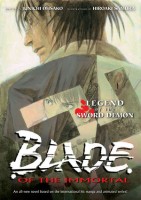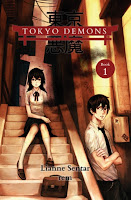 Author: Junichi Ohsako
Author: Junichi Ohsako
Illustrator: Hiroaki Samura
U.S. publisher: Dark Horse
ISBN: 9781595823380
Released: January 2010
Original release: 2008
Hiroaki Samura’s Blade of the Immortal was one of the first manga series that I began reading and it remains one of my personal favorites. When I learned that a novel based on the manga had been written I immediately picked it up. However, it did take me quite some time to actually get around to reading it. Blade of the Immortal: Legend of the Sword Demon, written by Junichi Ohsako with illustrations by Samura, was originally published in Japan in July 2008—the same month the anime adaptation of Blade of the Immortal began airing. I don’t know much about the author (Legend of the Sword Demon is the only novel by Ohsako to have been released in English), but I do know that Ohsako is a fellow fan of Blade of the Immortal. The English-language edition of Legend of the Sword Demon was translated by Camellia Nieh and released in 2010 by Dark Horse. Unsurprisingly, Dark Horse is also the publisher responsible for releasing the Blade of the Immortal manga and artbook in English.
Rin was the only daughter of Asano Takayoshi, the head of the respected Mutenichi-ryū sword school. A few years past he was brutally murdered before her very eyes, her mother was raped and abducted, and Rin was abandoned and left alone to fend for herself. Her family was destroyed at the hands of a group of renegade swordsmen known as the Ittō-ryū and their leader Anotsu Kagehisa. Now Rin is seeking her revenge, hiring an outlaw known only as Manji as her bodyguard. Rumored to be immortal, Manji has vowed to kill one thousand evil men to atone for hist past misdeeds. But is the Ittō-ryū truly evil? Whether it is or isn’t, Manji and Rin aren’t the only ones seeking the group’s demise. This complicates matters a great deal and it becomes difficult for Rin and Manji to determine who are friends and who are foes. Any alliances made in the fight against the Ittō-ryū can only be assumed to be temporary.
Legend of the Sword Demon is a very quick read. The story is a re-imagining of the early part of the Blade of the Immortal manga series. While the novel has some unique content of its own, including a dangerous enemy not found anywhere else, many of the scenes will be familiar to those who have read the original. All of the most popular characters make an appearance in the novel as well. (This was actually one of the conditions set by the publisher when the novel was initially commissioned.) Legend of the Sword Demon mostly focuses on the action of the story. Very little descriptive detail is given and the characters aren’t particularly fleshed out, either. It is interesting to see a slightly different take on Blade of the Immortal, but Legend of the Sword Demon almost requires that readers have a fairly firm grounding in the original series to really appreciate what Ohsako is doing with the story and characters. There might be enough in the novel to entice new readers to pick up the manga, but I am not at all confident of that.
In the end, I was actually rather disappointed with Legend of the Sword Demon. I can’t really recommend the novel to anyone but those who are Blade of the Immortal completists (a group of people to which I admittedly belong). Ultimately, Legend of the Sword Demon is a very insubstantial work and somewhat shallow, lacking the depth present in the manga series. It feels as though the novel is nothing more than tie-in promotional material. Ohsako may be a devoted fan of Blade of the Immortal but Legend of the Sword Demon isn’t long enough nor complex enough to really establish itself as noteworthy. It’s fun in places, but Legend of the Sword Demon is largely forgettable. The real highlight of the volume is Samura’s cover art and the handful of full-page illustrations that he created specifically for the novel. Otherwise, Legend of the Sword Demon is something that most people probably won’t regret passing over.




